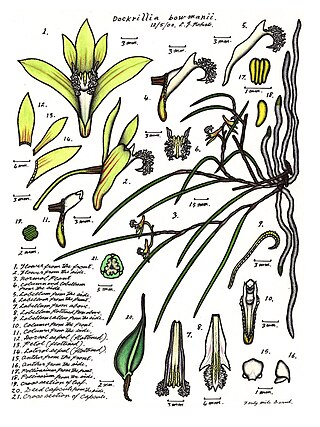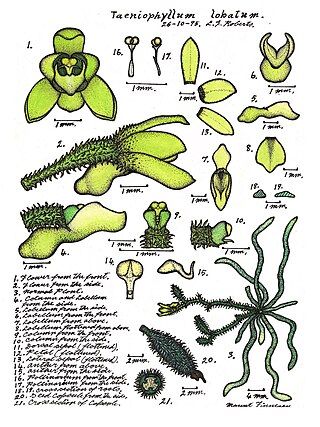Bulbophyllum argyropus, commonly known as the silver strand orchid, is a species of epiphytic or sometimes lithophytic orchid that is endemic to eastern Australia, including Lord Howe and Norfolk Islands. It has crowded pseudobulbs, tough, dark green leaves and up to four small whitish to yellowish flowers with an orange labellum.
Bulbophyllum bracteatum, commonly known as the blotched pineapple orchid, is a species of epiphytic or sometimes lithophytic orchid that is endemic to eastern Australia. It has crowded pseudobulbs, tough, pale green or yellowish leaves and up to twenty five cream-coloured to yellowish flowers with purplish or reddish blotches. It usually grows in the tops of rainforest trees.

Bulbophyllum elisae, commonly known as the pineapple orchid, is a species of epiphytic or lithophytic orchid that is endemic to eastern Australia. It has crowded, wrinkled, pale green or yellowish clump-forming pseudobulbs, stiff, pale green to yellowish leaves and between three and twelve pale green to dark green flowers with a dark red to purple labellum. It usually grows in the tops of rainforest trees, on cliff faces or boulders.
Bulbophyllum johnsonii, commonly known as the yellow snake orchid, is a species of epiphytic or lithophytic orchid that has a thin, creeping rhizome with flattened pseudobulbs, each with a single tough, dark green leaf and a single bright yellow to orange flower on a thread-like stalk. It grows on trees, shrubs and rocks in and near rainforest in tropical North Queensland.

Pultenaea muelleri, commonly known as Mueller's bush-pea, is a species of flowering plant in the family Fabaceae and is endemic to Victoria, Australia. It is a dense shrub with hairy stems, elliptic to narrow egg-shaped leaves with the narrower end towards the base, and yellow and red flowers arranged singly or in pairs on the ends of short side shoots.

Taeniophyllum, commonly known as ribbon roots or 带叶兰属 is a genus of about 240 species of epiphytic or lithophytic plants from the orchid family, Orchidaceae. Plants in this genus are more or less leafless with a very short stem and roots that are often flat, green and photosynthetic. The flowers are small, short-lived, flat or tube-shaped and arranged on short, thin flowering stems. Orchids in this genus are found in Africa, tropical and subtropical Asia, New Guinea, Australia and some Western Pacific Islands. It is extinct in Malawi.

Rhinerrhiza divitiflora, commonly known as the raspy root orchid, is the only species in the genus Rhinerrhiza from the orchid family, Orchidaceae. It is an epiphytic or lithophytic orchid with usually only a single stem, many flat, raspy roots, between two and six leathery leaves and up to sixty pale orange flowers with red spots and blotches. The sepals and petals are narrow, thin and pointed. It mainly grows on rainforest trees and is found between the Atherton Tableland in Queensland and the Hunter River in New South Wales.
Plectorrhiza erecta , commonly known as the upright tangle orchid, is an epiphytic or lithophytic orchid that has many coarse, cord-like roots, many bright green leaves and up to five yellowish orange, cup-shaped flowers with purplish blotches. It grows close to the ground on fibrous barked plants and only occurs on Lord Howe Island.

Podochilus australiensis, commonly known as the native stream orchid, is a species of epiphytic or lithophytic orchid. It has a fern-like appearance with many thin, twisted, glossy green leaves and clusters of up to six dull white or greenish flowers with a green labellum. It grows tropical North Queensland.

Dendrobium bowmanii, commonly known as the straggly pencil orchid, is an epiphytic or lithophytic orchid in the family Orchidaceae. It has thin wiry, straggly stems with a small number of small leaves and up to four greenish or brownish flowers with a conspicuous white labellum. It grows in drier rainforests and coastal scrub in New South Wales, southern Queensland and New Caledonia.
Drymoanthus minutus, commonly known as green midget orchid, is a species of epiphytic or lithophytic orchid that forms small clumps with many thick roots emerging from a thin, erect stem. Between two and five dark green, leathery leaves are arranged along the stem and up to seven minute green to yellowish, star-shaped flowers are arranged on a stiff flowering stem. The sepals and petals are similar to each other and there is a fleshy white, unlobed labellum. This orchid occurs in northern Queensland where it grows in rainforest, usually at higher altitudes.
Taeniophyllum clementsii, commonly known as the fleshy threadfoot, is a species of leafless epiphytic orchid which only grows as single plants. It has short stems and flattened green roots pressed against the tree on which it is growing. Between five and fifty small, pale green, tube-shaped flowers are arranged on a zig-zagged flowering stem. The flowers open one at a time, with the flowering stem increasing in length as each flower opens. This orchid only grows in a small area of tropical North Queensland.

Plectorrhiza brevilabris, commonly known as the small tangle orchid, is an epiphytic or lithophytic orchid endemic to Australia. It has many coarse, wiry roots, between three and nine bright green leaves and up to twenty green, star-shaped flowers with reddish brown markings and a white patch on the labellum. It grows in rainforest on trees, shrubs and occasionally on rocks and occurs on the near coastal ranges of eastern Queensland.

Schoenorchis micrantha, commonly known as the tangled flea orchid, is a small epiphytic orchid that forms small, tangled clumps and has thin stems, many linear leaves and up to thirty small, white, bell-shaped flowers. It is found from Indochina to the south-west Pacific.
Taeniophyllum confertum, commonly known as the crowded ribbonroot, is a species of leafless epiphytic orchid which only grows as single plants that form small clumps. It has short stems and flattened green roots pressed against the tree on which it is growing. Between five and ten pale green, tube-shaped flowers open one at a time. This orchid only grows in a small area of tropical North Queensland.

Taeniophyllum hasseltii, commonly known as the Christmas Island ribbonroot, is a species of leafless epiphytic or lithophytic orchid that forms small clumps. It has short stems and flattened silvery grey roots pressed against the substrate on which it is growing. The flowers are tube-shaped, pale yellow and open one at a time. This orchid is only known from Christmas Island, an Australian territory and the Indonesia island of Java.

Taeniophyllum lobatum, commonly known as the yellow ribbonroot, is a species of leafless epiphytic or lithophytic orchid that forms small clumps. It has short stems, flattened pale to greyish green roots pressed against the substrate on which it is growing and usually two pale to bright yellow flowers. It only occurs in tropical North Queensland.

Taeniophyllum malianum, commonly known as the tangled ribbonroot, is a species of leafless epiphytic or lithophytic orchid that forms tangled clumps. It has flattened green roots with irregular white spots and pressed against the substrate on which it is growing. There are up to fifteen fragrant yellow, short-lived flowers with up to three open at the same time. It only occurs in tropical North Queensland and in New Guinea.
Taeniophyllum norfolkianum, commonly known as the Norfolk Island ribbonroot, is a species of small, leafless epiphytic orchid. It has short stems, cylindrical green roots pressed against the substrate on which it is growing and between two and five small, tube-shaped, yellowish green flowers opening one at a time. It occurs on Norfolk Island but has also been reported from the North Island of New Zealand.

Liparis condylobulbon, commonly known as the tapered sphinx orchid or 细茎羊耳蒜 is a plant in the orchid family. It is an epiphytic or lithophytic orchid with crowded, glossy green, cylinder-shaped pseudobulbs, each with two linear to lance-shaped leaves and between fifteen and thirty five pale green to cream-coloured flowers with an orange labellum. This orchid usually grows on trees and rocks in rainforest from Taiwan and Indochina to the south-west Pacific.












